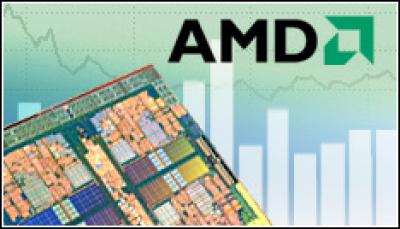

Advanced Micro Devices is beginning to see results in the aggressive rollout of its Fusion processors, which helped the company turn a $61 million (£37m) profit in the second quarter despite an overall softening of the PC market and the company’s continuing search for a CEO.
During a conference call with analysts and journalists to announce the vendor’s second-quarter financial results, Thomas Seifert, AMD’s CFO and acting CEO, said the company’s Brazos processors, for light-weight notebooks and netbooks, was an “unqualified hit” and was one of the fastest-ramping products the company has released.
“The success of the APUs demonstrate that we have the right strategy,” he said.
AMD launched is long-awaited Fusion initiative at the 2011 Consumer Electronics Show in January. The Fusion chips – dubbed APUs, or accelerated processing units, by the company – offer discrete-level graphics integrated onto the same piece of silicon as the CPU, helping to drive performance increases while reducing power consumption and costs.
The APUs now account for about 70 percent of notebook chip shipments and revenues for notebooks, according to AMD officials. They also represent about 40 percent of all chips sold by the vendor, and help increase average selling prices, which helped boost AMD’s bottom line in the first half of the year.
The APUs also will represent key tools in AMD’s push into the booming tablet market, currently dominated by highly energy-efficient chips designed by ARM Holdings and manufactured by the likes of Qualcomm, Texas Instruments and Nvidia.
AMD has been criticised for not pursuing the tablet space more aggressively. However, Seifert argued that the market was still in its early stages and there was time for AMD to gain traction.
“It’s still a very fragmented market,” he said. “It’s still a very small market, outside of the [Apple] iPad.”
He also dismissed claims that tablets were cannibalising the notebook book space, calling tablets “another computing device, so we believe it is an opportunity”.
AMD’s initial reluctance to pursue the mobile device space – including tablets and smartphones – is a key reason why the company is looking for a CEO. Former top executive Dirk Meyer had argued that AMD, the world’s second-largest chip maker behind Intel, should focus most of its efforts on its core PC and server businesses. That reportedly ran against what the board of directors wanted, and days after AMD launched the Fusion chips in January, Meyer resigned.
Analysts have said that the drawn-out CEO search is hurting AMD’s status with investors, and the number of high-profile names who reportedly have turned down the company’s overtures does not help. That group reportedly includes Apple COO Tim Cook; Pat Gelsinger, the long-time Intel executive who now is COO at EMC; and ex-Hewlett-Packard CEO Mark Hurd, now a president at Oracle.
However, AMD general counsel Harry Wolin said during the call that members of AMD’s executive search team are happy with the quality of the candidates they have met with and they are confident a strong CEO will be found. He declined to say when a person would be named.
Seifert (pictured) has said he is not a candidate but AMD has done well under his direction. The $61 million profit was a sharp change from the $43m (£26m) loss AMD posted during the same period last year. However, the company also saw revenues decrease five percent year-over-year – to $1.57 billion (£0.96bn) – though they were buoyed by higher average selling prices.
Seifert and other AMD executives said they expect the momentum to continue in the second half of the year. The Fusion APUs will continue to ramp. In addition, the company is readying the launch of a 16-core server chip, “Interlagos”, which will be based on the “Bulldozer” core. Rick Bergman, senior vice president and general manager of AMD’s Products Group, said the chip will roll out in the third quarter.
Bergman said during the call that he expects Interlagos will help AMD gain in market share in the server space.
Overall, AMD continues to trail Intel in the chip market. In June, market research firm IHS iSuppli said Intel in the first quarter held 82.6 percent of the worldwide chip market, a two percent increase over the same period last year. At the same time, AMD saw its share drop to 10.1 percent, down from 11.8 percent in the first quarter of 2010.
All Cybertrucks manufactured between November 2023 and February 2025 recalled over trim that can fall…
As Musk guts US federal agencies, SEC issues summons over Elon's failure to disclose ownership…
Moonshot project Taara spun out of Google, uses lasers and not satellites to provide internet…
Pebble creator launches two new PebbleOS-based smartwatches with 30-day battery life, e-ink screens after OS…
Amazon loses appeal in Luxembourg's administrative court over 746m euro GDPR fine related to use…
Nvidia, xAI to participate in project backed by BlackRock, Microsoft to invest $100bn in AI…